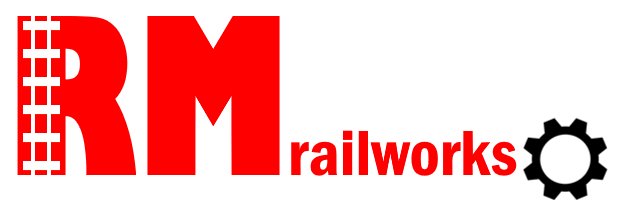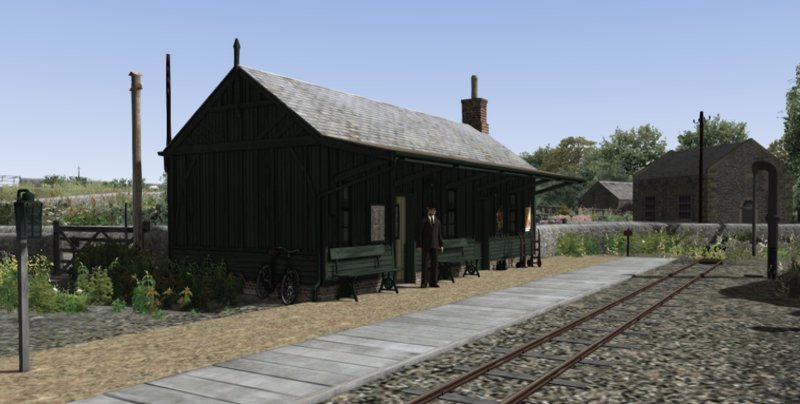
Hulme End
The home of the LMVLR. The decision to base the railway at a small village on a relatively unimportant road was because the original ambition was to extend the line to Buxton with Hulme End as the half way point.
Many aspects of the route are based on the LMVLR such as the station building, benches and platform light. However, there are aspects that I have changed for my preferences. The platforms are actually based on those on the Southwold Railway, as I happen to like the design. There is an interactive loco water point at the end of the platform.

Hulme End Sheds
The yard buildings are based on the real LMVLR designs. Both the engine shed and carriage shed have twin tracks. The carriage shed is just about long enough to fit two LMVLR coaches on each road.
The engine shed has inspection pits and a two-ton hoist outside. The water tower features an animated and interactive filling point. The lamp and oils shed stands between the water tower and the coal staithes. The coaling point is interactive and also has an interactive shovel to enable Southwold Railway wagons to unload loco coal brought up from Waterhouses yard.
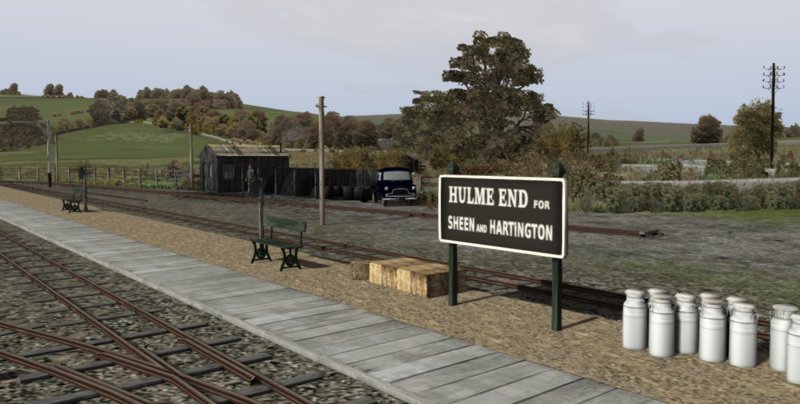
Hulme End Yard
The station yard is based on the real one. I have not included the lengths of standard gauge railway onto which wagons were unloaded from transporter wagons as these do not work correctly in TSC.
On the yard side of the platform there are interactive loading or unloading points (pick-ups) for milk churns and hay bales in Southwold Railway wagons. At the coal staithes there is a shovel to unload coal from Southwold wagons and my skips can be loaded with coal using an interactive coal sack.

Ecton
Ecton was the site of some of the most productive lead and copper mines in England. Although long-gone by the time of the LMVLR the landscape still bore the scars of the industry. The station was adjacent to the River Manifold and the line follows a down gradient from Hulme End as it follows the river valley to Beeston.
There is a large station loop here and a small local siding. I have used my block system so that sidings and loops are not blocked as part of the main route allowing them to act as passing places in scenarios.
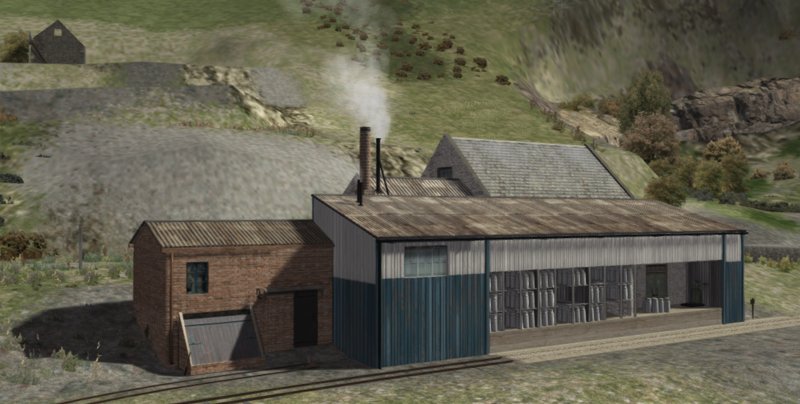
Ecton Dairy
The dairy at Ecton was built in 1918 and considerably helped the railway’s finances. Regular milk traffic on the line was shared between going direct to Waterhouses for onward transport or to the dairy for processing. The dairy was based in the old smelting sheds of the copper mines but gradually expanded to a substantial building.
I have modelled a smaller version of the dairy as it would have dominated the route. The dairy has interactive churns waiting to be picked up by a Southwold wagon. I added the boiler house with an unloader for skip wagon loads of coal.
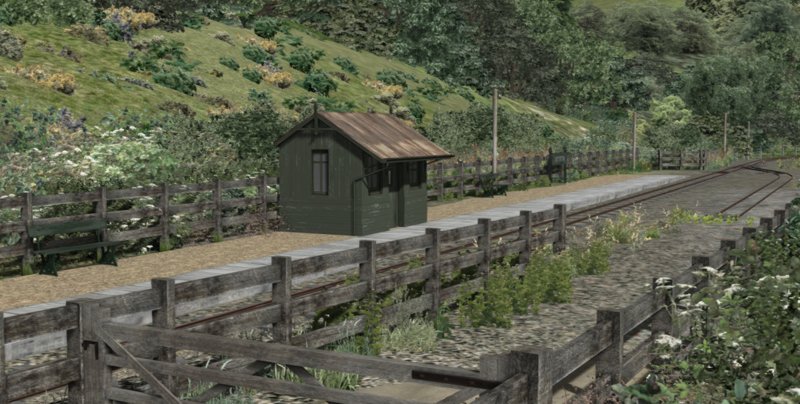
Butterton
Butterton Station is typical of the LMVLR. It is unlit and has a low platform, a station sign, and couple of benches. The waiting room is of the “Bungalow” design from the Portable Buildings Company.
Butterton Station served not only the village and area surrouding Butterton but also the residents and guests of Sir Thomas Wardle at Swainsley Hall. There was a siding where horse boxes were occasionally used to which I have added a hay bales pick-up for Southwold wagons.
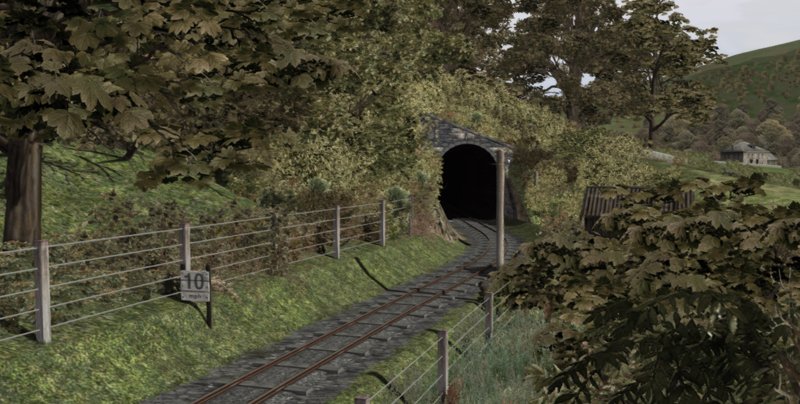
Swainsley Tunnel
Sir Thomas was a leading figure in the artistic world and insisted on a tunnel so that the railway would not spoil his and his artistic guests’ view. You can just see the hall in the background. The 170 yard tunnel was built large enough to fit a standard gauge horse box on a narrow gauge transporter wagon.
As the sign indicates the tunnel has a 10mph speed limit. Like all the speed limits on the line these are built as trackside objects and feature in the various HUDS and performance reports.

Wetton Mill
The mill had long since closed before the LMVLR was built but this was a favorite spot for visitors having both a stream for paddling and a cafe at the mill. A siding off the station loop provides for local goods.
All the platforms, loops and sidings on the route show as marked locations on the TSC map so that you can build scenarios based around them. All the points on the route are manually controlled.
Pick-up points for milk churns are located at one end of the platform.
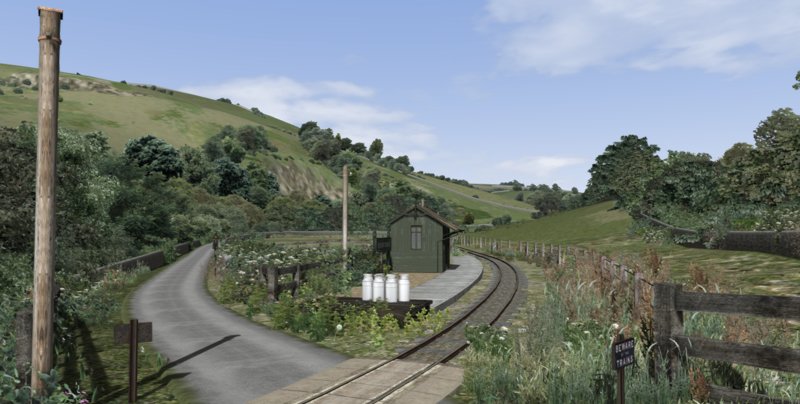
Redhurst Crossing
Originally Redhurst Crossing was just a milk churn platform beside the road. The short passenger platform and other station features being added sometime after the LMVLR started operation.
The milk platform has an interactive milk churn pick-up added for Southwold Railway wagons.
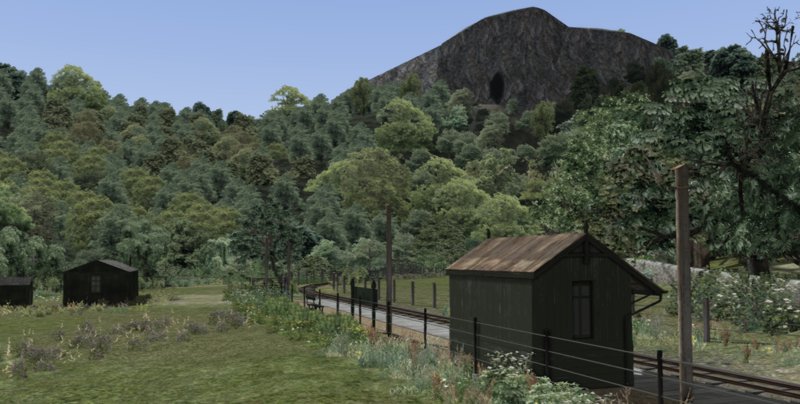
Thor’s Cave
The iconic image of the line is the large cave set high on a Limestone crag overlooking the railway. The halt sits close to a cafe, which replaced one that originally burnt down, for walkers on their way to visit the cave.
There is no siding or special facilities here other than a rather nice view. The cliffs are in shadow in this mid-summer evening view.
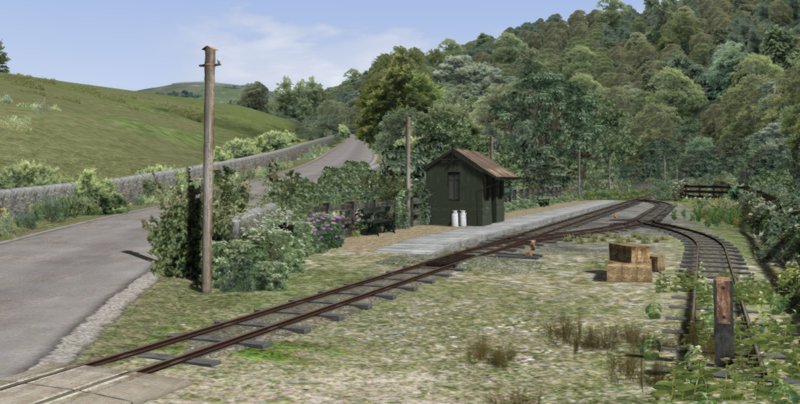
Grindon
Grindon station has a loop with a short siding. It is situated at the point where a road crosses the River Manifold before climbing out of the valley heading east.
This makes Grindon an important location for agricultural goods traffic. For this reason I have added both a hay bale and milk churn pick-ups for Southwold wagons.
If you wait at Grindon you will hear some of the bespoke atmospheric sound effects such as curlews, cattle and sheep that are typical of Pennine hills.

Manifold & Hamps
The lowest point of the railway is at Beeston Tor where the River Hamps joins the River Manifold. In this winter scene, the Manifold valley continues on from the viewer into the distance as the railway curves right to ascend the valley of the River Hamps.
As this is limestone country both rivers are dry for much of their length with occasionally flowing reaches between a spring and the next swallow hole.
The route has full seasonal textures including changes in road suface and track bed colours.
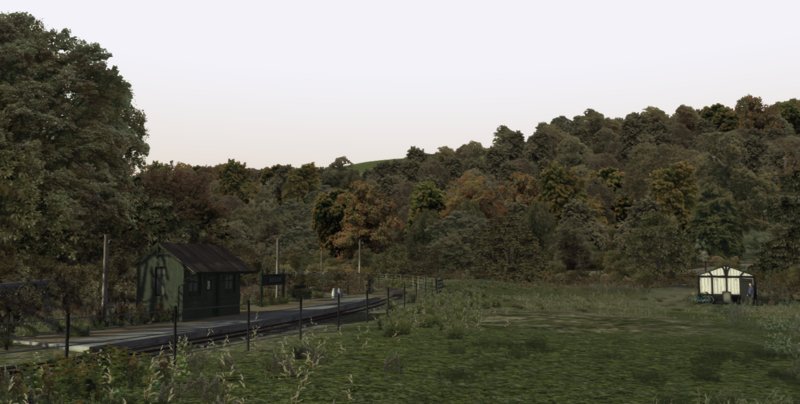
Beeston
Dusk on a warm summer evening at Beeston station. One of the shorter stations on the route it is frequented by the many climbers and tourists visiting Beeston Tor.
The fields around here were frequently used for camping and, for many years, there was always a scout camp in the field beside the black & white tea shop.
From here the gradients climb steeply and the valley is densley wooded. There are numerous bridges as the railway hugs the valley sides following the River Hamps.
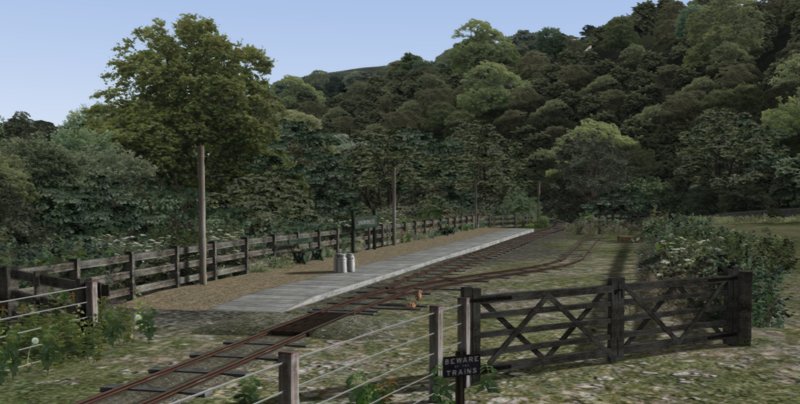
Sparrowlee
Leaving the most twisting section of the line and the Hell Hole Woods the halt at Sparrowlee didn’t even merit a building. It had a single siding that served just the local farms.
It was also a favoured destination for walkers as between Beeston Tor and Sparrowlee the River Hamps twists and turns in a rather scenic manner with many waterfalls.
There is a farm nearby and so there are milk churn pick-ups on the platform and hay bale pick-ups in the siding.

Waterhouses Station
At the top of a steep climb from the level crossing over the Waterhouses road, this station was the transfer point of goods and passengers for the standard gauge Cauldon branch to Leek.
The narrow gauge and standard gauge had separate station buildings with much of the milk traffic originally being off-loaded in barrows and man-handled up the standard gauge platform to waiting vans.
There are milk churn pick-up points for Southwold wagons located mid platform to reflect this activity.
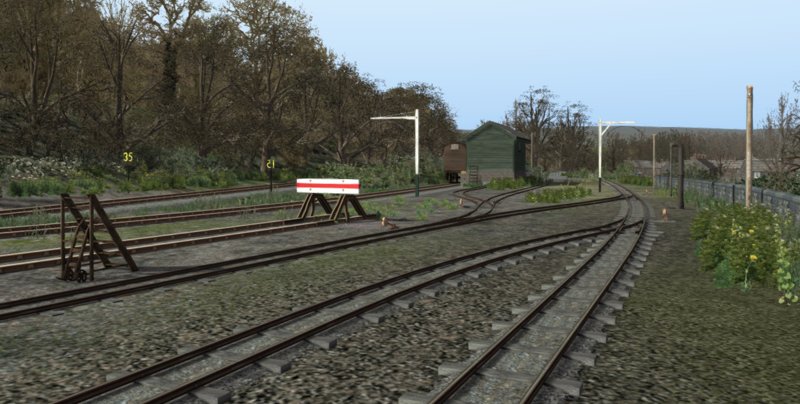
Waterhouses Yard
In real life this was the site of the famous transhipment of standard gauge wagons onto narrow gauge transporter wagons; a brilliant idea.
The basic layout of a narrow gauge run round, long headshunt and throw-back sidings has been retained but I have added the lines to the goodshed and removed the transporter loading lines. The goods shed is also an accurate model of the one that still exists today.
In the yard there are coal and hay bale pick-ups for Southwold wagons as well as coal pick-ups for my Skips. There is also an interactive water crane just beyond the run round loop.
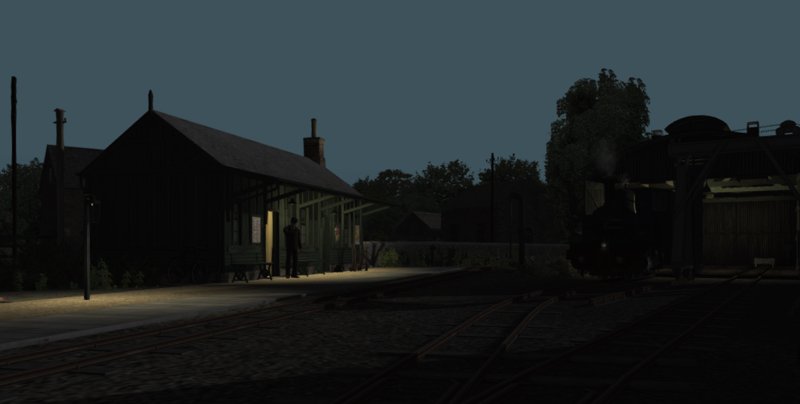
Scenarios and Quick Drives
I have not added any scenarios as these would require specific stock.
I have, however, added a complete set of quick drives that work with the latest version of my Narrow Gauge Quick Drives download.
I have changed the latest versions of these and my consists so that static stock is specific to its load. This means that only coal trucks appear at the coal yard and Ecton Dairy siding is limited to wagons appropriate to carrying churns or finished dairy produce.
